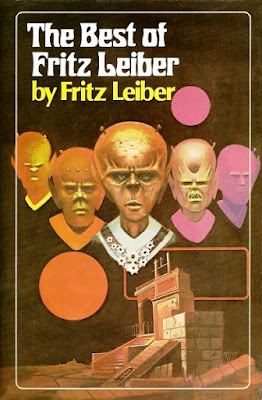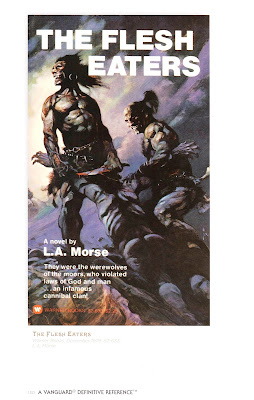Book Review: 'Swords Against Darkness IV', edited by Andrew J. Offutt
'Swords Against Darkness IV' was published by low-budget paperback publisher Zebra Books in September, 1979. The cover art is by Luis Bermejo.
I have to confess that, after reading 'My Father the Pornographer', Chris Offutt's 2017 memoir about his father, every time I encounter a book authored or edited by Andrew J. Offutt my mind's eye surveys things in the context of Offutt's prodigious output of sleaze books, and his petty resentments against other authors and editors in the fantasy and sci-fi genres, and I wonder what role all of that plays in the composition of the book in my hand......
Anyways, like the other volumes in the 'Swords' series, this one contains both previously published and original stories couched in the world of 'heroic fantasy', or as Offutt refers to it, 'hf.'
In his Forward, Offut states that the previous volumes in the series were grim in outlook, and thus, with volume IV, he was looking to include some tales that were lighter in tone.
My summary of the contents:
Mai-Kulala, by Charles L. Saunders: Imaro the African warrior ventures into the forbidding Ituri forest, there to experience Jungle Love. A competent story from Saunders.
At the Sign of the Brass Breast, by Jeff P. Swycaffer: in medieval Genoa, two thieves operate out of the eponymous bar. This is a comedic tale, and at times, I found it too cutesy.
The Reaping, by Ardath Mayhar: in the depths of a dank and dripping cave lurks an evil mage who can be defeated by no man.........
The Ballad of Borrell, by Gordon Linzner: an aging hero finds his past catching up with him. More reliant on dry humor, although it does have some rather bloody scenes.
Deux Amours d'une Sorciere ('Two Loves of a Witch'), by Tanith Lee: a precious tale of a lovelorn young woman who won't disclose the identity of the man she worships from afar. There is verse.....in French.......and lots of adjectives, and much descriptive prose.
Of PIGS and Men, by Poul Anderson: not a heroic fantasy fiction, indeed, not a fantasy tale at all, but an essay in which Anderson satirically casts Nordics as the victims of racial oppression. That Offutt decided to include this slight piece in the anthology tells me he was a bit uneven in attending to his editorial duties.....
Cryptically Yours, by Brain Lumley: written in the unusual style of an epistolary exchange, this tale is about elderly wizards confronting a conspiracy that seeks to have them all eliminated. Clever, inventive, and one of the best entries in the anthology. It was selected by Lin Carter for the DAW volume 'The Year's Best Fantasy Stories 6.'
The Dark Mother, by Diana L. Paxson: a Shanna the Swordswoman tale, and an effective one, at that. Our heroine must deal with some girls who have Bad Intentions.
Dedication, by Andrew J. Offutt: a 26 year-old would-be contributor to the 'Swords Against Darkness' franchise, named David Madison, killed himself before Offutt could make one of Madison's manuscripts sufficiently coherent to be publishable. Volume IV thus is dedicated to Madison (but doesn't include one of his stories).
Wooden Crate of Violent Death, by Joey Froehlich: a six-page, blank verse poem about some 'oystermen' who recruit a swordsman to do some killing. Editor Offutt claims he subjected this submission to 'eighty million' drafts. For all that, one of the verses in the poem is:
Along the river, the forests wept, their leaves falling like tears of autumn sadness
The Fane of the Grey Rose, by Charles de Lint: a 'Cerin Songweaver' entry. Our hero seeks to save a fair maiden. This story later was expanded into the 1985 novel 'The Harp of the Grey Rose'. It is sugary and insipid (de Lint uses the term 'aelf', a conversant is a 'speaker-friend') but strangely readable.
After I finished 'Fane', I had to read David J. Schow's 'Bad Guy Hats', to reset the glucose balance of my brain. This is not something one should do lightly.........
Sandmagic, by Orson Scott Card: Cer wants revenge, and he'll go to any lengths to get it. This story's bleak setting, and quasi-splatterpunk violence, make it impactful.
The Edge of the World, by Manly Wade Wellman: a 'Kardios' tale that mixes sly (but never irreverent) humor with the sword-and-sorcery trope. Enjoyable.
Summing up, there are enough good stories in 'Sword Against Darkness IV' to give it a Four-Star Score. Given that 'good' quality copies of the books in this franchise are fetching very high prices nowadays ($10 and up), if you can find the book for an affordable price, it's worth getting.









_from_Blood_Hunt_Vol_1_2_001.jpeg)




























%20-%20Page%2012.jpg)



%20-%20Page%208.jpg)













